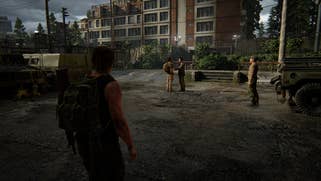The Last of Us Part 1 and Part 2 on PS5 Pro: the best way to play the Naughty Dog saga
PSSR upscaling works well - and the VRR unlocked frame-rate boosts are satisfying.
The Last of Us series has only had two main entries - but Naughty Dog has made the most of those two games with a variety of remasters and remakes. PS5 Pro puts a capstone on those follow-up efforts though, by delivering both contemporary Last of Us iterations at 4K60 using PSSR. These patches also provide an interesting console benchmark, because the old PS5 modes are available on PS5 Pro, giving us a rare test to compare the Pro and base machine in like-for-like content in a Pro enhanced title. So does the PS5 Pro deliver the definitive Last of Us experience? And exactly how well do the old modes scale on the boosted Pro GPU?
Naughty Dog keeps things simple with these new patches: PS5 Pro offers just one new visual mode across both Last of Us games, a new "Pro" option, in addition to the old performance and fidelity modes. This Pro mode renders at 1440p like the old performance mode, but upscales the image to 4K using PSSR. Other visual settings appear unchanged. Relative to the performance mode, there's a substantial visual improvement. In stills, the image has a compelling combination of enhanced image detail and more effective anti-aliasing, producing a substantially better image on a 4K display.
The biggest improvement is seen on foliage, which looks more natural and clean. There's a generous helping of post-process sharpening on the base machine, which appears much more subdued or possibly even absent on the Pro. It's definitely a change for the better in this case, giving grass a smooth appearance without edge ringing. The differences are especially obvious in motion, with foliage appearing clearer, with the standard PS5 having a noisy, undersampled look by comparison. The Pro delivers somewhat less sterling results on thin geometry, but it's usually similar to - or better than - the base machine. I also prefer the Pro rendition of screen-space reflections. Testing for disocclusion issues doesn't reveal any particularly bad artifacting on Pro either: PSSR tends to blur a little in areas of the frame with recently revealed detail, which is definitely preferable to typical FSR 2-style disocclusion fizzle.
The only real downside on PS5 Pro is that there's low-level instability to the image, which presents like a film grain effect, even with film grain disabled. It's mild relative to other games we've looked at recently, and it's not overly distracting. I also occasionally noticed geometric seams on PS5 Pro, which can shimmer and become visually obvious in some circumstances. Again, it's a minor issue. I also spotted an issue with water flickering very occasionally.
My commentary has covered The Last of Us Part 1 so far, but the fact is that Part 2 is much the same. PSSR behaves similarly in both games, so the visual outcomes relative to performance mode are about the same. The biggest image quality difference between the games doesn't actually have anything to do with the new Pro modes: the old performance and fidelity modes have more aggressive sharpening in Part 1 than Part 2 for some reason, but the new Pro modes appear similarly sharp across both games. There's also an issue on PS5 Pro with the shadowmaps in at least one part of The Last of Us Part 2. I noticed this in Santa Barbara, where the shadows appear to flicker excessively. I think shadow resolution is the same, but there's some other issue that's leading to an odd, jittered appearance. I wasn't able to spot this issue elsewhere though.
Conquering the old native 4K fidelity mode proves a bit tougher for the Pro. The fidelity mode tends to handle thin geometry a bit more adeptly, with less obvious aliasing artifacts, but I sometimes prefer the look of foliage on the Pro in motion. It does tend to blur elements like grass together a little, but I think that's preferable to the aliasing seen on the standard PS5. In stills, both machines look comparable enough. The Pro looks a bit more unstable, but presents smoother edges and more refined foliage. From a normal viewing distance I think both do a good job of serving a 4K display.
On the whole, I'd probably slightly edge towards the old fidelity mode in image quality terms, but the two are close. Of course, the more important comparison is to the old performance mode, which targets the same 60fps update. Performance is fairly straightforward here with these games operating with v-sync on PS5 Pro, because they mostly hit their performance targets perfectly. The Pro and performance modes run at 60fps, and the fidelity mode runs at 30fps at 60Hz output or 40fps at 120Hz output when the unlocked toggle is turned on. I did notice a couple of exceptions in the new Pro mode in known trouble spots in The Last of Us Part 1, but elsewhere the game hits a locked 60.
Comparisons suggest the performance and fidelity modes on Pro are identical to their counterparts on the base PS5, so the stable performance there is to be expected. The fidelity modes still run at 4K, while the performance mode is still 1440p, so neither stresses the Pro too hard at their frame-rate targets. Smooth operation in the new Pro mode is less of a given, but the PS5 Pro seems perfectly capable of pulling off a 4K image at a solid 60fps using PSSR with only rare exceptions.

However, the performance question becomes a lot more interesting when you unlock these games using VRR and 120Hz output. Players receive elevated frame-rates across both PS5 and PS5 Pro consoles, but the Pro runs substantially faster using the same modes. At most, there is a 25fps advantage on the new console, which translates to circa 29 percent frame-rate improvement in GPU-heavy scenes - and that is enough to push the Pro to 120fps in some content. Of course, we don't know the extent to which the game may be CPU-limited in some scenarios, but it's still an interesting datapoint on Pro performance. I did notice that Part 2 tends to run a little faster than Part 1, which makes sense given that it was originally built for PS4 consoles.
The PS5 performance vs. Pro mode comparison is also somewhat illuminating. The PS5 Pro runs with its various enhancements at a very similar frame-rate to the base machine in performance mode, suggesting that the extra GPU time is basically tapped out. Sometimes it actually runs slightly slower than the base PS5. Higher-res post processing and PSSR seem to eat up just about all of the additional performance margin on Pro. Comparing PS5 Pro in its performance and Pro modes, we see that there's typically about a 3ms to 3.5ms gap in frame-times between the two modes, giving us a rough idea of how expensive the PSSR upscale process with upgraded post processing may be. It's not terribly costly, all things considered, but the Pro hardware is running a little behind expectations in this title.
Of course, these are just patches for two older games that may be on old SDKs. It's entirely possible that a new game built with the Pro in mind may get a greater frame-time improvement, especially if it uses ray tracing. I would compare the fidelity modes as well, but because of low-frame rate compensation in VRR (which can double or triple the same frame), the refresh rate readings are inaccurate. Judged by eye, I expect the frame-rate uplift is probably comparable to the performance mode, with 50-60fps gameplay fairly common now.




Lastly, I wanted to quickly evaluate PSSR versus FSR and DLSS in The Last of Us Part 1. I used FSR 2 and DLSS with the sharpening sliders set to their lowest values, because I think PS5 Pro is operating with minimal or absent post-process sharpening, and I dialled the PC to broadly equivalent PS5 settings. FSR actually fares well against PSSR at rest, delivering a delivers a more stable image than PSSR, and it looks slightly sharper. In motion, though, FSR tends to alias somewhat more on foliage, and perhaps a little more on fine geometry. PSSR's noise makes the comparison fairly equal overall.
PSSR does a pretty solid job of minimizing disocclusion issues though, which are a bit of an FSR pain point. Plus, PSSR is quite a bit sharper in motion, which is a common feature of PSSR implementations. Overall, I think FSR fares fine here - and I'm a little surprised it didn't make an appearance in the PS5 version of The Last of Us Part 2 - but I'd probably give the nod to Sony's new upscaler. DLSS does feel a few steps ahead in terms of image stability. At rest it's basically faultless, and it looks smooth when moving through a scene or swinging a punch. Even the performance mode scores a superior result here, exhibiting fairly minimal aliasing across a range of content.
The one substantial compromise with DLSS is that image clarity takes a hit in motion relative to PSSR. Sony's solution does a good job of maintaining image detail with the camera moving. Clarity at rest is similar, though, which is when image detail differences are more noticeable. DLSS is clearly the better solution here in quality mode, but it's surprising just how good performance mode looks when paired against PSSR, even with a big pixel count disadvantage. Sony's upsampler isn't at this level, but if it can get there in the future, that could free up a lot of GPU time for other purposes.












Overall, I'd say that the PS5 Pro patches for the two contemporary Last of Us titles are successful. Naughty Dog has delivered on the PS5 Pro promise here by essentially delivering a solid 4K60 visual mode in both games. Plus, the FPS boost with unlocked frame-rates on VRR displays is substantial relative to the base console, with frame-rates often in excess of 100fps with the performance preset.
PSSR acquits itself fairly well in these games, for a few reasons I think. They are running at a high resolution, have a good frame-rate, use high res post processing, and rely heavily on lightmaps. The upsampling doesn't have to contend with noisy undersampled RTGI, or aliased low-res geometry. The result is imagery that is pretty comparable to native 4K rendering, without some of the issues associated with hand-authored upscaling algorithms like FSR. That's not to say that it's faultless, or that certain issues - like PSSR's distinctive noise - aren't also present. But the results are broadly satisfactory in my opinion. Envelope-pushing games on PS5 Pro have greater demands, and PSSR will have to develop to serve those titles more effectively as well.
But for now, the PS5-native Last of Us games are delivered in great form on PS5 Pro. The base PS5 was already a good venue for these two titles, but the Pro offers an extra level of refinement for enthusiast gamers.


